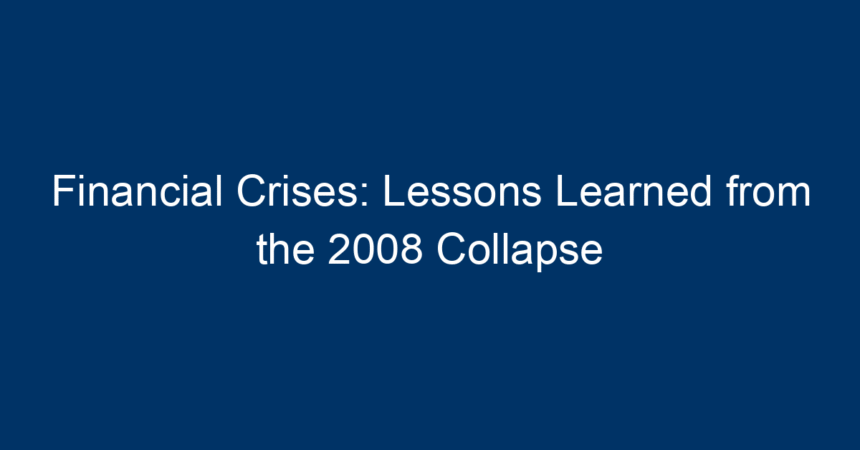The financial landscape is a tumultuous sea, often marked by booms and busts. Among the most devastating events in recent history was the financial crisis of 2008. Triggered by a perfect storm of factors, this crisis shook the very foundations of the global economy and sent ripples through every sector. Understanding its causes and the lessons learned is crucial to preventing future financial crises.
In this article, we’ll explore the key factors that led to the 2008 collapse, the fallout from the crisis, and the important lessons we can apply moving forward. By the end, you will have actionable insights to take away, ensuring that we are better prepared for the inevitabilities of the financial world.
Understanding the 2008 Financial Crisis
The Precipitating Factors
The financial crisis of 2008 was not an isolated incident but rather the culmination of a series of events that extended over several years. A significant driver was the housing bubble, fueled by risky subprime mortgages. Banks, in their quest for profit, began offering loans to individuals with poor credit histories, lured by the prospect of high returns.
Deregulation of Financial Institutions
Deregulation played a key role in exacerbating the risk. Over the years, important safeguards were removed, allowing financial institutions to engage in increasingly risky practices. Notably, the repeal of the Glass-Steagall Act in 1999 allowed commercial banks, investment banks, and insurance companies to merge. This lack of oversight meant that institutions could take on excessive risks without the checks and balances previously in place.
The Role of Financial Instruments
Complex financial instruments, such as mortgage-backed securities (MBS) and collateralized debt obligations (CDOs), became prevalent during this period. These instruments were touted as safe, diversified investments but were built upon underlying assets of questionable quality. When homeowners began defaulting on their loans, the value of these securities plummeted, leading to widespread financial turmoil.
The Fallout: A Global Economic Repercussion
Market Collapse
The crisis reached a boiling point in September 2008 when Lehman Brothers filed for bankruptcy. This marked a pivotal moment, triggering a massive sell-off in stock markets around the world. Major financial institutions were threatened, leading to government bailouts, which further fueled public outrage.
Unemployment and Economic Slowdown
The economic slowdown that followed was unprecedented, with millions losing their jobs and homes. The unemployment rate soared, with some estimates indicating it peaked at nearly 10%. This economic distress created a ripple effect, leading to a prolonged recession that lasted several years.
Erosion of Public Trust
Perhaps one of the lasting impacts of the 2008 financial crisis was the erosion of public trust in financial institutions. Many felt betrayed by the very organizations that were meant to protect their interests. This loss of faith had profound implications for consumer spending and investment, further prolonging the economic recovery.
Lessons Learned from the 2008 Financial Crisis
Importance of Regulation
One of the most significant lessons learned from the 2008 collapse is the need for robust financial regulation. The post-crisis era saw the introduction of reforms such as the Dodd-Frank Act, which aimed to increase oversight and reduce the likelihood of excessive risk-taking. Regulatory bodies need to ensure that financial institutions prioritize long-term stability over short-term gains.
The Significance of Transparency
Transparency is vital in rebuilding trust. Financial institutions must be held accountable for their actions, and consumers should have access to clear, comprehensible information about products and services. This transparency helps consumers make informed decisions, ultimately contributing to a healthier economy.
Understanding Financial Products
Consumers should enhance their understanding of complex financial products. Awareness of the risks associated with MBS, CDOs, and other instruments can help individuals make wiser investment choices. Education is a critical tool in preventing future financial crises.
Risk Diversification
Diversification is a fundamental principle of investing that many investors ignored before the 2008 crisis. Concentration in high-risk assets can lead to catastrophic losses. Engaging in diversified investment strategies helps mitigate risks, providing a buffer against market volatility.
The Role of Leadership
Strong leadership is essential, particularly in times of economic turmoil. Financial institutions must cultivate a culture of ethical decision-making and prioritize responsible risk management. Leaders should encourage open dialogues about potential risks and foster an environment where employees feel comfortable voicing concerns.
Actionable Insights for the Future
Stay Informed and Educated
To protect yourself and your assets from potential financial crises, it is crucial to stay informed. Regularly follow financial news, read industry analyses, and understand macroeconomic indicators that may signal impending downturns.
Create a Financial Plan
Developing a sound financial plan is essential. Factor in risk tolerance and create a diversified portfolio that aligns with your long-term goals. Regularly review and adjust your plan according to market conditions and personal circumstances.
Cultivate an Emergency Fund
Emergencies can happen at any time, especially in uncertain economic climates. Aim to save 3-6 months’ worth of living expenses in an easily accessible account. This financial cushion can provide much-needed peace of mind during turbulent times.
Engage with Financial Professionals
Consider working with qualified financial advisors who can provide personalized guidance. They can help navigate complex financial products, assess risks accurately, and develop tailored investment strategies that align with your goals.
Focus on Ethical Investing
Consider the ethical implications of your investments. Engage with companies that prioritize transparency and exhibit ethical business practices. Supporting responsible businesses can contribute to the overall health of the financial ecosystem.
Conclusion
The 2008 financial crisis serves as a stark reminder of the vulnerabilities within our economic systems. By understanding the factors that led to its collapse and the lessons learned, we can better equip ourselves for the challenges ahead.
Implementing robust regulations, embracing transparency, and enhancing financial literacy can lead to a more stable financial future. The lessons of the past should guide us as we navigate the complexities of today’s financial landscape.
With vigilance, informed decision-making, and a commitment to responsible finance, we can certainly work toward minimizing the risk of future financial crises.




